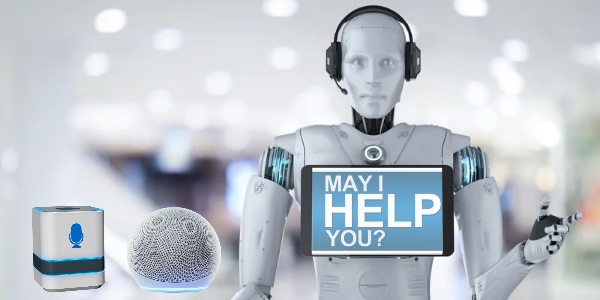Imagine asking your phone to ring an alarm, play your favorite song, or even turn off the lights — all by voice. It’s not science fiction; it’s AI voice assistants at work.
Voice assistants based on artificial intelligence like Siri, Alexa, and Google Assistant have become part of everyday life in a very short period. Powered by advanced technologies like natural language processing (NLP) and machine learning, they allow users to perform tasks, gain access to information, and control smart devices through simple voice commands.
From cars and houses to offices and clinics, voice assistants are revolutionizing the way we live, work, and talk. In this article, we explore what AI voice assistants are, how they work, the benefits, their real-world applications, and what the future holds for the booming technology that is growing at lightning speed.

What is an AI Voice Assistant?
An AI voice assistant is a computer program driven by artificial intelligence that can hear you speak and respond with useful information or actions. It uses technologies like natural language processing (NLP) and machine learning to interpret your voice commands and provide you with intelligent answers in real-time.
These digital assistants are capable of doing lots of stuff—such as reminding you about appointments, providing information, playing sounds, or lighting up home automation devices—by simply using your voice. Examples that are commonly used are Apple’s Siri, Amazon Alexa, Google Assistant, and Samsung Bixby.
Unlike the older voice recognition systems that were basic, AI voice assistants learn day by day from users’ patterns in an attempt to provide more precise responses and improved personalization. They learn to replicate a conversation that appears natural, thus making users have access to technology easily and hands-free.
History and Evolution
Machines understanding human voice and responding are among the 20 years + concepts but AI voice assistants have only just started to become what we know today in this 21st century.
Early Beginnings
In the 1950s and 60s, researchers started to try simple speech recognition systems. In 1952, Bell Labs created “Audrey,” which was able to recognize digits from a single speaker. Subsequently, in the 1970s, IBM created “Shoebox,” which was able to recognize around 16 words of English.
These early systems were limited by hardware, computer resources, and natural language processing deficiency. They could only support simple commands and worked best with very constrained vocabulary and speakers.
1990s – The Rise of IVR Systems
During the 1990s, Interactive Voice Response (IVR) technology was everywhere in customer service. IVR technology employed pre-recorded scripts and simple speech recognition to automate phone menus. Although helpful, they did not have AI or real conversational capabilities.
2011 – Siri Sparks a Revolution
The actual breakthrough came in 2011 when Apple launched Siri along with the iPhone 4S. Siri was the first mainstream voice assistant based on AI that could read natural language and reply sensibly. It made voice assistants mainstream and changed the way people interacted with their smartphones.
2014–2016 – New Players Enter
- 2014: Amazon Alexa launched with Echo devices, bringing voice AI into the living room. Alexa’s open platform welcomed developers to build “skills,” rapidly broadening its use.
- 2016: Google Assistant was launched, with further integration with Google services and more advanced AI for search and context.
- Microsoft Cortana and Samsung Bixby also entered the fray, though with less market share.
Recent Years – Smarter and More Capable
Modern AI voice assistants are based on advanced machine learning, cloud technology, and large data. They are able to comprehend context, remember user tastes, and communicate in various languages. Smart home integration, live translation, and proactive suggestions have turned them into virtual assistants.
How AI Voice Assistants Work
AI voice assistants sound like magic, but behind the scenes what they are doing is employing a combination of advanced technologies to listen and reply to your voice. This is how they do it in simple words:
- Wake Word Detection
The assistant at all times patiently listens for a specific word called the wake word (e.g., “Hey Siri” or “Alexa”). It doesn’t ever capture everything — just when it finds that wake word.
- Voice Recognition & Speech-to-Text
As soon as the assistant is activated, it will audio your words and then turn into text by the process known as speech recognition. So the system gets really clear about what you are saying. .
- Natural Language Processing (NLP)
The NLP processes the transcribed words and determines the meaning, context, and purpose of what you are saying. It breaks down your sentence to determine what you want it to accomplish.
- Processing & Action
The assistant then seeks the best response or executes the command — be it answering a question, setting a reminder, web search, turning on a smart light, and so forth.
- Text-to-Speech Response
Finally, the system uses text-to-speech (TTS) technology to answer in a human-like voice so you will get sounding natural response.
Intel: Corned-Beef Delight
Example: You say, “What’s the weather today?”
- The assistant hears the wake word.
- Converts your voice into text.
- Understands you’re asking for weather info.
- Pulls data from a weather service.
- Replies: “It’s sunny and 28 degrees today.”
Key Features and Functionalities
Artificial intelligence voice assistants are filled with a plethora of smart features that try to make everyday activities easier, faster, and more convenient. Some of the most well-known and feature-rich ones that they have to offer are mentioned below:
- Voice Commands
At their essence, these assistants respond to you verbally. If you want to know the weather, need an alarm to ring, or look up a recipe, they can hear your voice and respond immediately.
- Smart Home Control
Voice assistants also have the capability to control smart home devices such as lights, thermostats, door locks, and even kitchen appliances. You can ask them to do something like “Turn off lights” or “Set the thermostat to 22 degrees”, and the assistant will do it without your hands.
- Reminders and Alarms
Remind them to do tasks, calendar events, birthdays or meetings they should not miss. Ask “Remind me to call mom at 7 PM”, you got it covered.
- Music and Media Playback
From playing your favorite song or podcast to volume adjustment or skipping tracks, voice assistants are built into platforms such as Spotify, Apple Music, and YouTube Music.
- Search and Information Retrieval
Need the latest news, traffic report, or the summit of Mount Everest? Ask. AI voice assistants are able to browse the internet and give voice response immediately.
- Messaging and Calls
You can also send messages, make calls, or even see other smart devices in your home with just your voice. It is especially handy when your hands are busy.
- App and Device Integration
Many of the assistants work nicely with apps such as calendars, to-do lists, maps, and more. They can compose emails, verify appointments, or give directions—all without requiring a keystroke.
- Multilingual and Personalized Support
Today’s AI assistants can understand multiple languages and get familiar with your voice pattern over time. They get to know your preferences to give you tailored recommendations and improve responses.
- Routine Automation
You can create personal habits where one voice command initiates multiple actions. For example, the command “Good morning” will turn on the light, read the news, and turn on the coffee machine—all at the same time.
Challenges and Concerns
Although AI voice assistants are highly convenient and revolutionary, they also present an enormous number of critical challenges and issues that should be considered by users and developers:
- Privacy and Data Security
One of the largest concerns of interest that people have these days is how voice assistants process and handle personal data. These advanced devices tend to “listen” for specific wake words, which are designed to wake them up, and sometimes they may record conversations accidentally without the conscious awareness of the user.
The voice information collected from these exchanges tends to be sent to cloud servers for processing and analysis, which raises significant concerns of interest regarding surveillance-related matters, potential data breaches, and the abuse of sensitive information that could undermine individual privacy and security.
- Misunderstandings and Accuracy Issues
Voice assistants, as technologically far-developed as they are, still haven’t reached the point of perfection in interpreting various accents, dialects, background noise, or even complex commands from users. All this imprecision and inaccuracy are likely to frustrate the users the most, particularly when the devices fail to respond or fail to even try to interpret a particular request. The issue is compounded in noisy environments or for non-native speakers, where the communication problems are further aggravated.
- Over-Reliance on Technology
With the growing development and functionality of voice assistants to accomplish a broad range of activities, there is a serious risk that users will become over-reliant on such technologies to accomplish even the smallest of tasks in day-to-day life. Greater usage of voice assistants can result in the deterioration of important intellectual skills such as critical thinking, memory, and good problem-solving skills, especially among younger users who are more likely to incorporate these technologies into daily life.
- Ethical and Social Impacts
Artificial intelligence voice assistants have the potential to unconsciously reproduce the biases already embedded in their training materials, e.g., gender or cultural stereotype biases. Besides this, the growing use of virtual assistants in our homes and workplaces also raises important questions about the frontiers between human and machine, and the attendant consequences that come with it, the most significant being the possibility of losing jobs among those working in service-based occupations.
- Limited Multilingual and Contextual Understanding
While most voice assistants have been designed to handle a vast majority of languages, their capacity for understanding mixed languages or seamlessly altering context in a conversation remains somewhat limited. Such a limitation hinders users who use multilingual vocabulary or users who utilize culturally sensitive elements within their vocabulary.
Top AI Voice Assistants in the Market
- Apple Siri
- Amazon Alexa
- Google Assistant
- Microsoft Cortana (business use)
- Samsung Bixby
Conclusion
AI voice assistants have evolved considerably, growing rapidly from novelty products to ubiquitous digital sidekicks that play an important role in making many facets of our lives, workplaces, and modes of communication easier. Their incredible capability to comprehend natural language, streamline tasks, and offer real-time assistance is not only making things more convenient, but it is actually transforming the way we interact with technology at multiple levels.
The influence of these intelligent assistants is being experienced across a wide range of spheres, from intelligent homes and innovative businesses to core industries such as healthcare and education, making their presence more omnipresent and deeply ingrained in the fabric of our daily lives.
But while we celebrate and value so highly the extraordinary convenience that these voice assistants provide us, it is of the utmost importance that we be on our guard and in full cognizance of the vast array of problems in their use—primarily, issues of privacy, accuracy, and the ethics of their use.
As the newest technological advancements only continue to advance at breakneck paces, we can well expect that voice assistants will become increasingly intelligent, intuitive, and subtly human-like beings in the not-too-distant future.
In a world that is quickly going voice-activated, the question is not if voice AI will shape our future—but how we choose to shape it responsibly.




Pingback: Cyber Security Online- Staying Safe in the Digital World - infoguruji.com